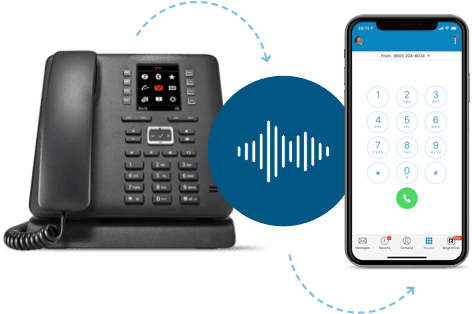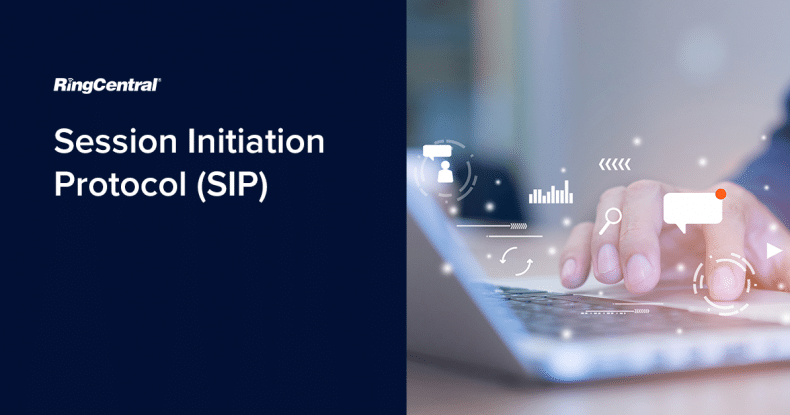In this article, we'll cover:
What is Session Initiation Protocol (SIP)?
SIP stands for session initiation protocol. Session Initiation Protocol is a widely used telephony protocol that establishes a voice or audio media session over the telephone.
SIP forms the foundation of any voice over internet protocol (VoIP) phone call, including voice calls, video conferencing calls, mobile calls and messaging. SIP-telephony works in tandem with VoIP telephony by first establishing the session, then managing the signalling to support data packets travelling over the internet. SIP is also responsible for terminating the communication session.
An internet protocol is essentially a set of rules that defines how devices communicate with one another. SIP collaborates with VoIP, which, somewhat confusingly, isn’t actually a protocol in itself. VoIP is an overriding term for transmitting voice data that is prioritised to be transmitted with internet protocol.
It’s important to know no protocols are used in isolation when transmitting voice data between connected devices. Many different protocols work in tandem to form a ‘protocol stack’. When it comes to IP telephony, many different protocols alongside SIP are in play. These include session description protocol (SDP), real-time transport protocol (RTP), RTP control protocol (RTCP), transmission control protocol (TCP) and user datagram protocol (UDP), all of which work together to support the transportation of voice data packets over the internet connection.
What is SIP used for?
SIP is used for establishing, signalling and controlling a multimedia communications session. It is the protocol used for making and receiving these voice and multimedia sessions. This could be within a simple audio phone call between private telephone systems, application voice and video calls, and instant messaging over internet protocol.
How does SIP work in a VoIP call?
Each VoIP user has what is called a SIP address. SIP works essentially by establishing a call connecting one SIP address to the other before the call’s data transfer can occur.
The fundamental part of a VoIP call using SIP is the call signalling. Essentially SIP works by establishing the initial connection between two interlocutors: outbound caller and call receiver.
SIP doesn’t have to be used just for audio calls either. Video sessions are also initiated using SIP and instant messaging ‘sessions’, which pass data from one internet user to the other.
As we mentioned earlier, SIP doesn’t work in isolation but with several other internet protocols. One such protocol is the session description protocol (SDP). Where SIP manages signalling between IP endpoints, SDP deals with details of a SIP-enabled session. SDP works in connection with SIP to establish the details of a multimedia session. For example, session description, time description and media description are all part of the SDP remit.
When it comes to carrying the actual information during the session, this involves transporting audio information encoded using codecs, which translate these signals into binary. This means they are transportable as data packets to be carried via the internet.
Once the encoded packets are ready, they are then transported via RTP, the real-time transport protocol. This specialised application layer enables what we know as real-time audio or video streaming. RTP runs independently but in connection with SIP when it comes to internet telephony.
RTCP refers to RTP control protocol which is responsible for monitoring service quality by overseeing the number of data packets exchanged within a call and lag time and the number of packets lost. RTCP allows us to monitor call quality and service information.
Major functions
The key functionality of SIP protocol for VoIP sessions is to open the floor for a call or data interchange session. This establishment of two SIP phones connecting is often referred to as the ‘call setup’ aspect of the two-phase approach to a traditional phone call, the second being ‘data transfer’. The data transfer uses a different set of protocols, essentially transporting data packets between each SIP address.
As we’ve mentioned previously, SIP doesn’t just establish a connection between those wanting to conduct a phone call. The function of SIP is to initiate a connection between two or more participants of any multimedia VoIP telephone calls, instant messaging conference or session.
What are the requirements for SIP telephony?
SIP technology is rapidly becoming the method of choice for enabling business VoIP calls. Ultimately, if you have a SIP-enabled PBX (private branch exchange) or a unified communications solution, you’ll be ready to use SIP-telephony.
SIP trunking is the most common use of SIP-telephony, which connects your business PBX and the public telephone network (PSTN), meaning you can do away with legacy phone lines (ISDN).
To deploy SIP telephony, you’ll need a computer with internet connectivity, a SIP-enabled PBX IP phone or VoIP business phone system and a reliable SIP service provider to install a SIP trunk.

Originally published Nov 16, 2020, updated May 20, 2021


